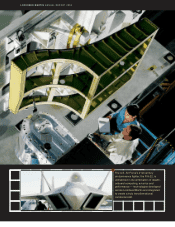Lockheed Martin 2004 Annual Report Download - page 20
Download and view the complete annual report
Please find page 20 of the 2004 Lockheed Martin annual report below. You can navigate through the pages in the report by either clicking on the pages listed below, or by using the keyword search tool below to find specific information within the annual report.
Highlights
The financial section of our Annual Report describes our ongo-
ing operations, including discussions about particular lines of
business or programs, our ability to finance our operating activ-
ities and trends and uncertainties in our industry and how they
might affect our future operations. We also discuss those items
affecting our results that were not considered in senior manage-
ment’s assessment of the operating performance of our business
segments. We separately disclose these items to assist in your
evaluation of our overall operating performance and financial
condition of the consolidated company. We would like to draw
your attention to the following items disclosed in this financial
section and where you will find them:
Topic Location(s)
Critical accounting policies:
Contract accounting/
revenue recognition Page 22
Post-retirement benefit plans Page 23 and page 58
Environmental matters Page 25, page 48 and page 64
Discussion of business segments Page 28 and page 65
Liquidity and cash flows Page 33 and page 44
Capital structure and resources Page 35, page 43 and page 45
Legal proceedings, commitments
and contingencies Page 36 and page 62
Stock-based compensation Page 37, page 49 and page 57
INDUSTRY CONSIDERATIONS
Defense Business Considerations
The markets for defense and related advanced technology systems
for 2005 and beyond will continue to be affected by the global war
on terrorism, through the continued need for military missions and
reconstruction efforts in Iraq and Afghanistan and the related fis-
cal consequences of war. The realities of the war on terrorism have
focused greater attention on the security of our homeland and bet-
ter communication and interplay between law enforcement, civil
government agencies, intelligence agencies and our military serv-
ices. At the same time, our nation’s overall defense posture contin-
ues to move toward a more capabilities-based structure, which
creates the ability for a more flexible response with greater force
mobility, stronger space capabilities, enhanced missile defense and
improved information systems capabilities and security.
We anticipate that the next Congressionally mandated
Quadrennial Defense Review (QDR) undertaken by the U.S.
Department of Defense (DoD) will reinforce and advance
efforts at the DoD to refocus activities toward joint operations,
net-centric command and control, and integrated capabilities
for the armed forces. To address this customer priority, we
formed the Integrated Systems & Solutions business segment
and established the Center for Innovation to help us better focus
our integrated solutions capabilities across the Corporation and
enhance our ability to serve as a lead partner with the DoD.
The President’s budget for fiscal year 2006 and beyond
represents an agenda for a second term in office, and presents
a framework to reduce the federal budget deficit while aggres-
sively prosecuting the global war on terrorism. The rate of
growth for budget increases at the DoD is reduced, while
spending across non-defense federal agencies is projected to
decline through 2011. These changes in the White House
budget plan reflect a commitment to cut the federal budget
deficit in half by 2009, and sentiment expressed by the
Federal Reserve that sustained federal deficits could hamper
economic growth.
The Future Years Defense Plan (FYDP) submitted with the
President’s budget request for fiscal year 2006 projects a
strong commitment to research and development of transfor-
mational capabilities across the military services, while reduc-
ing quantities of near-term systems compared to previous
projections. As has been widely reported, the President’s
budget request for fiscal year 2006 includes $419.3 billion for
overall defense spending and proposes reductions in funding
for a number of existing defense programs, including out-year
reductions to the F/A-22 and C-130J programs and termination
in 2006 of the Joint Common Missile and other programs in
which Lockheed Martin participates. We are actively partici-
pating in and monitoring discussions regarding these propos-
als, but are unable to predict the extent to which these
proposals ultimately will be approved as part of the 2006 or
subsequent budgets approved by Congress or what the ultimate
impact on Lockheed Martin would be. Many key decisions on
future program quantities and force structure will be reached
through the QDR and the Base Realignment and Closure
(BRAC) actions to be undertaken in 2005. Budget pressures
within DoD also may create additional opportunities for busi-
ness process management and outsourcing of service functions
by the military services, expanding the scope of private sector
contracting opportunities at the DoD.
In September 2004, Congress passed an initial $25 billion
supplemental appropriation to defray costs for Operation
Lockheed Martin Corporation
MANAGEMENT’S DISCUSSION AND ANALYSIS OF FINANCIAL CONDITION AND RESULTS OF OPERATIONS
December 31, 2004
18
18
























